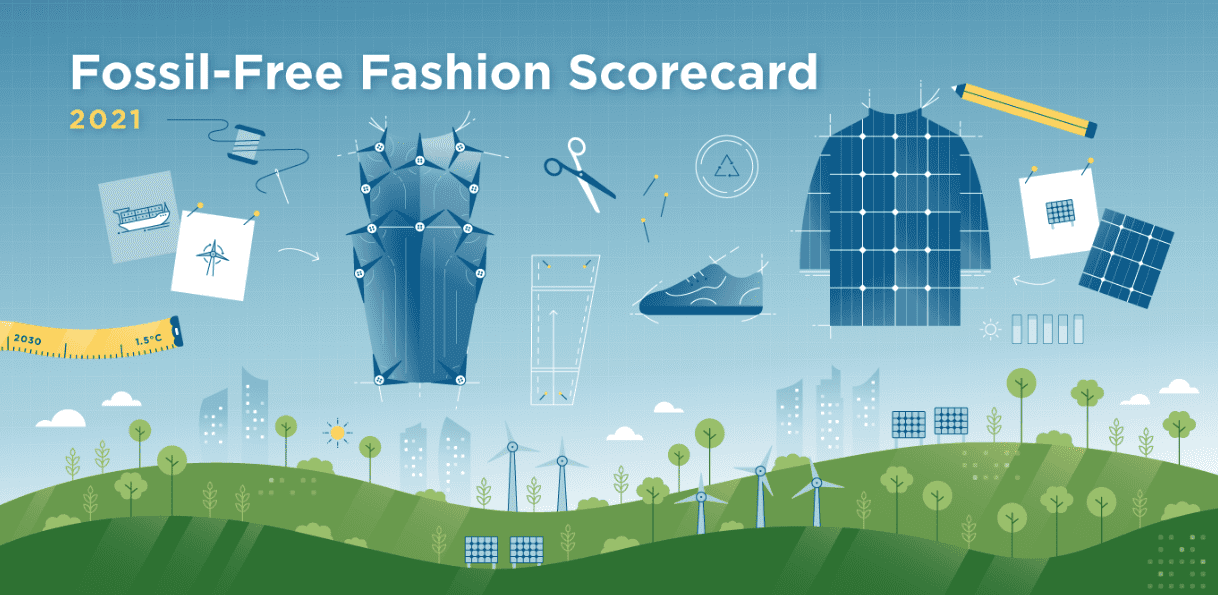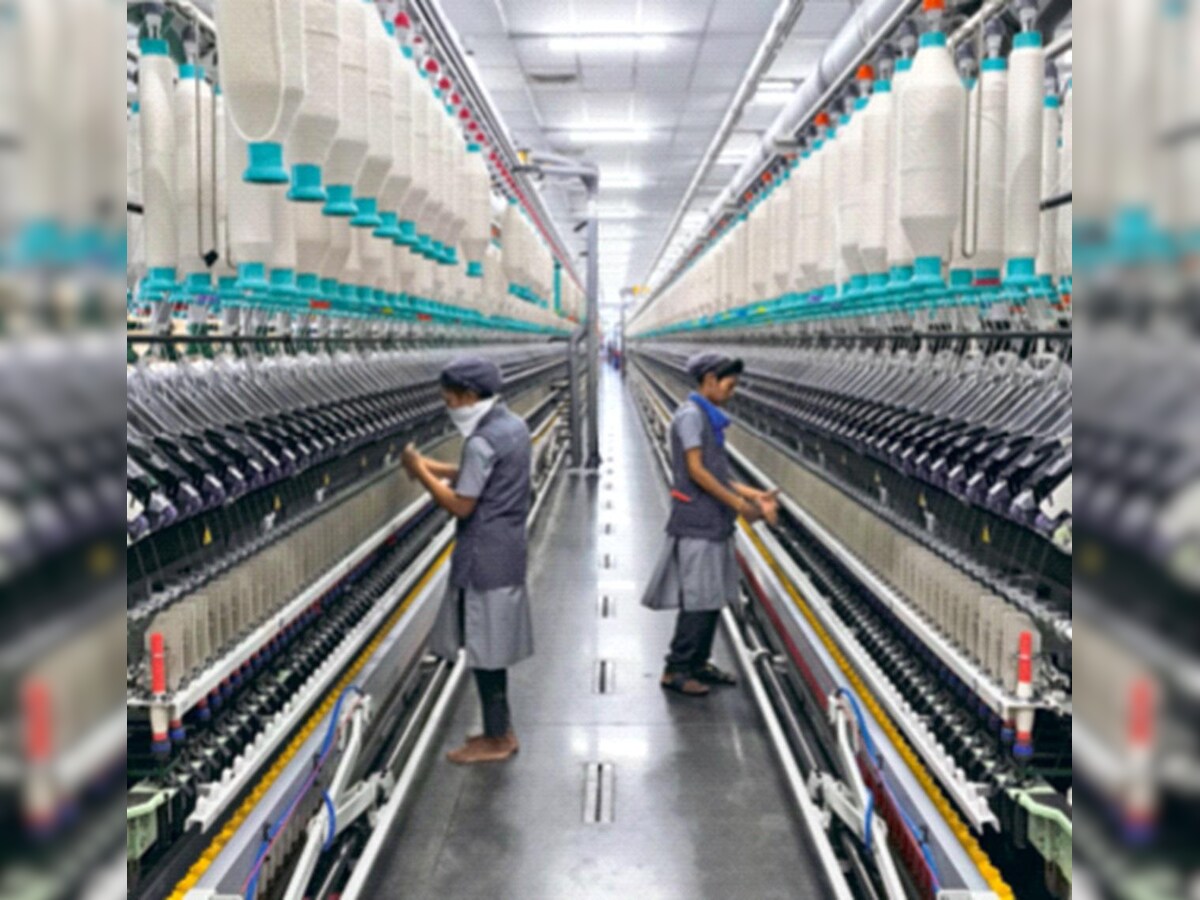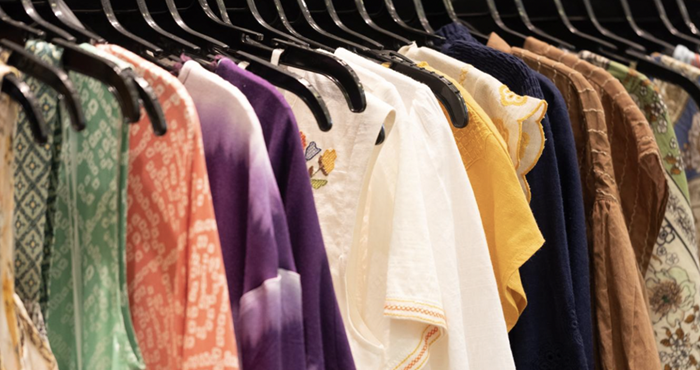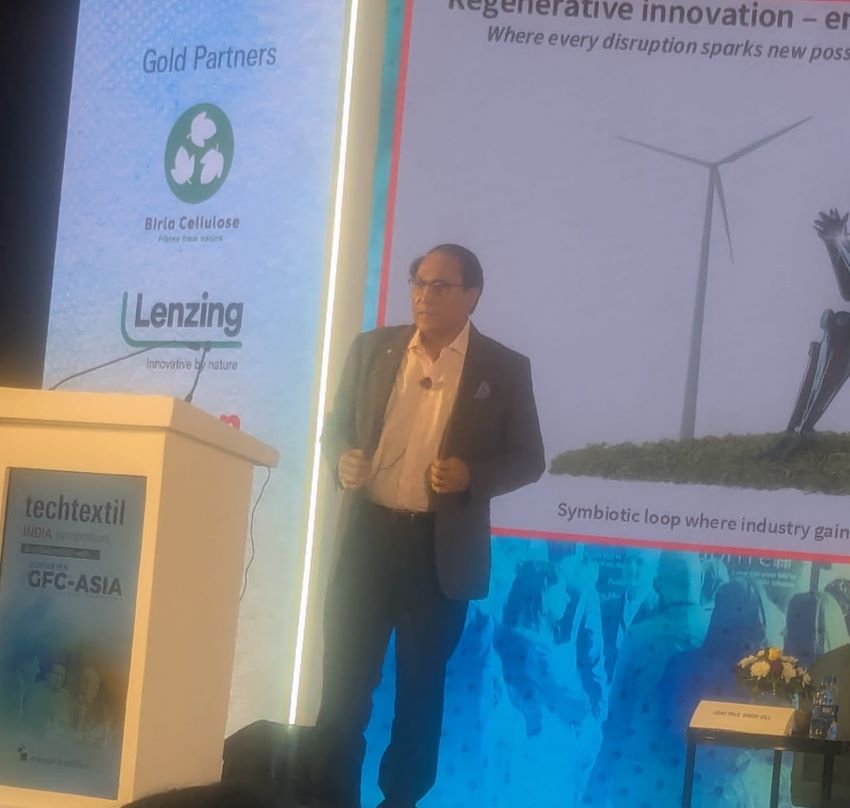FW

For years, the global fashion industry has promised a cleaner, greener future but 2025’s Fossil-Free Fashion Scorecard by STAND.earth offers a sobering verdict: not a single major brand has earned an ‘A’ for decarbonization. Despite public pledges, glossy sustainability reports, and high-profile climate campaigns, the sector remains on an emissions pathway ‘far from compatible’ with the 1.5°C target.
The scorecard, which assessed 42 of the world’s most influential fashion and apparel companies concludes that while some leaders are emerging, most brands are failing to confront their dependence on fossil fuels. The report also exposes a ‘systemic blindspot’ in how the industry addresses equity and support for workers affected by climate impacts. “The industry has a lot of work left to do to end its symbiosis with the fossil fuel economy,” the report warns a blunt assessment that echoes through the industry’s global supply chains.
When promises meet the planet
Despite years of climate pledges, the report found that the fashion sector’s total emissions trajectory continues to rise, defying its own targets. Only three brands viz. Eileen Fisher, Burberry, and Prada have reduced emissions in line with a 1.5°C pathway. Seventeen brands actually increased their carbon footprints compared to their baseline years.
The scorecard emphasizes that while data transparency is improving, actual decarbonization on the ground remains minimal, especially across the energy-intensive Tier II, III levels of supply chains (fabric dyeing, spinning, and raw material processing).
Who pays for the transition?
Perhaps the most glaring gap is financial. Only six of 42 brands (14 per cent) reported offering any kind of decarbonization project financing to their suppliers. Among these, H&M Group was the sole brand with significant, non-debt-based financing initiatives. In contrast, two-thirds of all brands showed no evidence of financing decarbonization leaving suppliers to bear the costs of transitioning to renewable energy.
This imbalance exposes a deeper structural flaw: while brands set ambitious emissions targets, their manufacturers primarily in Asia remain underfunded, trapped in thin-margin contracts that discourage sustainability investments.
Glimmers of progress
Not all the findings were bleak. There are visible shifts in two areas: renewable energy targets and circular fashion. 12 of 42 companies (29 per cent) now have measurable supply chain renewable electricity goals, up from only five in 2023. Nearly 95 per cent of brands now offer resale or repair programs, showcasing circularity has moved from the fringes of sustainability to the mainstream business model. However, the report notes that these programs often have limited scale and negligible impact on overall emissions unless integrated with material phase-outs and renewable sourcing.
Fossil fibers still rule the loom
Almost 70 per cent of all textile fibers are fossil-fuel-based synthetics such as polyester, nylon, and acrylic, a figure that has barely budged despite growing awareness. Only six brands (14 per cent) have committed to phasing out fossil-based materials. Among leaders, Kering (C+) and Eileen Fisher (B-) earned top marks for advancing regenerative material sourcing and reducing synthetic reliance. Yet even these leaders struggle against the global economics of synthetics: oil-based fibers remain far cheaper than natural or recycled alternatives.
H&M Group, the decarbonization outlier
The Scorecard’s top performer, H&M Group (B+), demonstrates what leadership looks like in practice.
• Transparency: H&M earned an A+ in Commitments and Transparency for disclosing a detailed Scope 3 roadmap that includes Tier III suppliers, a rarity among peers.
• Investment: The company publicly reported investing SEK 1.7 billion ($160 million) in decarbonization projects across its value chain, setting a new standard for financial disclosure.
• Renewables: By 2024, H&M’s supply chain achieved 36 per cent renewable electricity, with 9 per cent generated on-site and 7 per cent sourced through PPAs.
• Advocacy: It also became the first global brand to sign a green energy MOU in Vietnam under the country’s new Direct Power Purchase Agreement (DPPA), signaling a hands-on approach to policy engagement.
The report notes that this “model of supplier financing and policy advocacy” is the blueprint others should follow though even H&M, with its B+ rating, remains short of full fossil fuel phase-out alignment.
The polluters’ list
At the other end of the spectrum lie brands whose emissions are skyrocketing led by Shein, the ultra-fast fashion giant.
• Shein’s emissions surged from 9.17 million metric tons CO₂e in 2022 to 16.68 million in 2023 a 170 per cent jump.
• That’s almost equivalent to the annual emissions of Lebanon, according to the report.
• The main culprit: air freight, which accounts for nearly 40 per cent of its upstream shipping emissions.
Alongside Shein, other laggards include Boohoo, Under Armour, Next, Aritzia, and Columbia, all of which received ‘F’ grades in multiple categories, primarily for failing to set Scope 3 reduction targets or to disclose credible data.
The message is clear: fast fashion’s growth is directly tied to escalating pollution and without intervention, the climate cost will be catastrophic.
The human blindspot
In one of its starkest findings, STAND.earth’s Scorecard reveals that not a single brand could show evidence of climate adaptation programs for workers despite growing climate-related risks across textile-producing regions.
Floods in Bangladesh, heatwaves in India, and droughts in Vietnam threaten supply chain continuity and worker safety. Yet, none of the 42 brands had designed or funded programs developed in consultation with local stakeholders. This ‘dangerous blindspot’ the report warns, could undermine the very communities on which the global fashion system depends.
What comes next
The report ends with a stark call to action. In a world grappling with trade wars, greenwashing probes, and inflation, climate action risks being deprioritized. But abandoning it now, STAND.earth argues, would mean irreparable harm to both supply chains and people.
To align with a 1.5°C pathway and ensure justice for workers, brands must:
1. Fund the transition: Move from loan-based support to direct, non-debt financing for suppliers including long-term purchasing contracts that guarantee revenue stability.
2. Phase out fossil fibers: Commit to a transparent, time-bound plan for eliminating oil-derived materials and invest in scaling regenerative and circular fibers.
3. Support workers: Create worker-centered adaptation plans, co-designed with local communities, to safeguard livelihoods against climate shocks.
4. Clean up shipping: Cap air freight at 1 per cent of total goods and accelerate adoption of zero-emission vessels and last-mile logistics.
From optics to outcomes
Fashion’s climate credibility is on trial and 2025’s Scorecard delivers a verdict of missed opportunities. The few bright spots, like H&M’s transparency and Kering’s material innovation, are exceptions in a sector still powered literally and figuratively by fossil fuels. For an industry built on reinvention, fashion’s slow pivot toward sustainability is paradoxical. Without decisive financial, material, and human investments, its climate promises risk becoming the next season’s discarded trend.
Premium stretch fiber by Asahi Kasei, Roica is set to make a significant return to ISPO Munich 2025, showcasing its latest advancements in responsible stretch fiber technology. The brand will be featured prominently at the Asahi Kasei booth.
This year, Roica is highlighting a curated collection of samples from seven key European textile partners. These collaborations demonstrate the versatile and high-performance applications of Roica in the sports and activewear market. These partners include Brugnoli, Cifra, Iluna Group, Inplet Pletiva, Penn Solutions, Sitip, Tessitura Colombo Antonio
The official uniforms for the Expo 2025 Osaka, Kansai are adopting Roica V550. This material is being used in collaboration with Craftevo-V&A Japan, pioneering a new model for compostable, circular event apparel.
A strategic partnership with Nilit is focused on developing an innovative fabric concept. This concept aims for a reduced environmental impact by combining Nilit's Sensil By-Nature Nylon 6.6 with Roica produced using a mass balance approach with renewable feedstock.
India’s textile sector is currently undergoing a significant development as a new wave of consolidation begins in Surat, the country’s largest textile manufacturing hub. Market sources confirm,a major investment push is underway, highlighted by the recent acquisition of more than eight textile manufacturing companies in the city. The combined output of these acquired units is estimated to cover nearly 0.8 percent of the national textile market, signaling one of the most notable expansion steps in the sector this year.
The acquisitions have immediately created a ripple effect across Surat’s wholesale markets. Traders report visible shifts in early demand, competitive pricing strategies, and supply-chain expectations. Analysts describe the development as a ‘clear disruption’ led by a new entrant possessing significant financial strength and a clear long-term intent. Early assessments suggest this move could profoundly alter competitive dynamics, especially for mid-sized textile producers.
Industry sources indicate that negotiations are currently progressing for the acquisition of multiple large-scale fabric manufacturing units, which would further expand the new entity's footprint in Surat. Crucially, the investor is also reportedly exploring extensive land procurement for cotton cultivation.
This move hints at the establishment of a fully integrated value chain that spans raw materials, production, and distribution. If successfully executed, such a model could fundamentally reshape cost efficiencies and manufacturing capabilities across the entire region.
The entire investment push is being spearheaded by Ramkumar Sankarapandian, Founder and CEO, Qpay and SpaceQ. Ramkumar is well-known for successfully scaling Qpay across international markets and guiding SpaceQ’s progress in the space-technology domain. His entry into textiles has attracted industry-wide attention due to his established track record of leveraging technology, operational discipline, and global networks to scale businesses.
Sector analysts say his involvement signals a long-term transformation rather than a marginal presence. As one expert noted, Sankarapandian’s strategy reflects the foundation of a future textile empire.
With more transactions anticipated in the coming months, the textile industry is closely monitoring this expansion, anticipating broader shifts in manufacturing capacities, supply chains, and overall market competitiveness across India.
YKK Corporation has announced its highly anticipated debut at CES 2026 (Consumer Electronics Show), the world's largest technology exhibition, held in Las Vegas, Nevada, in January 2026. YKK will showcase groundbreaking innovations that focus on ‘Fastening the Future: Where Technology Meets Design,’ demonstrating how the company is redefining everyday functionality.
At its inaugural CES presence, YKK will present new possibilities for fastening solutions that seamlessly fuse technology and design. Visitors will discover how YKK is leveraging smart, sustainable, and connected technologies across its vast product lineup, which includes zippers, snaps, hook-and-loop fasteners, and buckles, available in over 70 countries.
A key highlight of the exhibition will be a range of innovative concept models, including an intriguing autonomous zipper. Through these exhibits, YKK aims to share its vision for creating new value and shaping the future of manufacturing through advanced fastening technology.
Northern Europe’s biannual fashion trade show, The Copenhagen International Fashion Fair (CIFF) has entered into a major strategic partnership with Danish technology firm Delogue to launch ‘TechCreate a CIFF Collaboration.’ This initiative is designed to bridge the gap between fashion and technology, making its physical debut at CIFF 66, running from January 27–29, 2026, in Copenhagen.
The initiative is built on three key pillars. The first was a webinar held on November 26, where stakeholders discussed how technology can boost creativity, optimize production, and improve industry transparency.
The second, and most prominent pillar, is the dedicated TechCreate physical space at CIFF 66. This immersive exhibition area will host demonstrations, talks, and collaborations exploring the future of design, production, distribution, and sustainability. CIFF aims to emphasize the vital role of digital tools, sustainability data, and workflow optimization in both the creative and commercial processes of the industry.
The final pillar involves a continuous content series on CIFF Media, the fair's digital platform, featuring interviews, trend analyses, and conversations with leading innovators.
Sofie Dolva, Director, CIFF, avers, TechCreate puts innovation on center stage. The organization’s partnership with Delogue provides a platform where creativity and technology meet, and where visibility is transformed into knowledge and action A tech company specializing in PLM (Product Lifecycle Management) for fashion brands, Delogue views the partnership as an opportunity to ensure technology empowers creatives. The initiative is also co-created with several technology partners, including the transparency platform tex.tracer, the ERP solution TRIMIT, the procurement digitizing tool E-SCM, and the data exchange platform Fashion Cloud. By embedding technology storytelling directly into its physical and digital presence, CIFF’s ambition is to make technology an essential ctex.tracer,omponent of creativity and sustainability for both established and emergE-SCM, ing brands.
Rapidly transforming apparel into a lower-carbon industry requires collaboration, innovation, and creativity. In this spirit, Sensil by NILIT and Roica by Asahi Kasei have collaborated to introduce the concept of a new fabric with less environmental impact, combining Sensil ByNature, a NILIT Biomass Balanced Nylon 6.6 yarn, and Biomass Balanced Roica premium stretch fiber, both designed for high-performance apparel.
Both companies utilize textile raw materials created through the Biomass Balance (BMB) approach, which utilizes renewable feedstocks made from reclaimed and recycled organic waste that does not compete with food sources, nor need the use of land for its production.
Sensil ByNature is the first textile Nylon 6.6 yarn for apparel made using a Biomass Balanced renewable feedstock sourced from biogenic waste. Meanwhile, Biomass Balanced Roica premium stretch fiber incorporates renewable raw materials in place of traditional fossil hydrocarbons. Roica will focus its Biomass Balanced (BMB) efforts at its Taiwan plant, the company’s key reference hub for BMB production.
Because BMB products are identical to traditional products, the resulting fabrics engineered with Sensil ByNature and Biomass Balanced Roica retain the comparable comfort, aesthetics, and performance as their conventional counterparts. This means that apparel brands can integrate these environmentally conscious fabrics without redesigning collections.
The companies use Biomass Balance accounting and third-party certification to appropriately allocate the percentage of renewable feedstocks to their products so that brands and consumers can rely on the sustainability claims. In addition, the companies are certified under the International Sustainability and Carbon Certification Plus (ISCC+) system, ensuring rigorous control and transparency in renewable feedstock use across the supply chain. This partnership will contribute to reducing environmental impact. NILIT’s Sensil ByNature lowers greenhouse gas emissions by about 1.8 kg CO₂ eq per ton of yarn versus traditional nylon.
Asahi Kasei projects that the new Roica Biomass Balanced stretch fiber, combined with manufacturing optimizations, will reduce CO₂ emissions compared to existing products. However, since production decisions have only just been made, exact numbers are not yet available.
When blended, Sensil ByNature and Biomass Balanced Roica stretch fiber help designers create outstanding stretch fabrics that substantially reduce a garment’s environmental footprint, lessening reliance on fossil resources, supporting circularity initiatives through renewable inputs, and improving Life Cycle Assessment, while maintaining the premium look, feel, comfort, or stretch performance consumers expect.
Global athletic brand Puma has significantly amplified its retail presence with the opening of its new London flagship store in the heart of Oxford Street. Spanning an impressive 24,000 sq ft, the store is the brand’s largest-ever European flagship. Its strategic location is near Selfridges and the Bond Street Tube Station, placing it in one of Europe’s busiest shopping hubs.
The store features key Puma innovations, including the running technology Nitro, its top-tier football boots Future, Ultra, and King, along with the current lifestyle product range. High-tech installations include a digital running video-wall that reacts to touch, and an archive area showcasing iconic pieces from the brand’s 77-year history.
To mark the launch, the store carries a London Exclusive collection designed by VP Creative Direction & Innovation Heiko Desens, which reinterprets British icons like the Union Flag and Harris Tweed through a modern Puma lens.
Arthur Hoeld, CEO, Puma says, the new store gives Puma the chance to connect with more people than ever before - right in the heart of one of the world’s most iconic shopping destinations. It is a powerful platform to engage directly with consumers, showcase our latest performance innovations, and strengthen our brand presence.
The store’s striking glass-fronted exterior and distinctly urban interior, which utilizes grey and white as base tones to highlight the colorful products, ensure high visibility. The flagship will host a dynamic program of events through late 2025 and into 2026, including athlete appearances, exclusive collaborations, a pre-race Hyrox experience on December 3, and a motorsport event on December 11, highlighting the Puma x Aston Martin F1 Team partnership.

India’s huge textile industry, long celebrated for its command over cotton and competitive manufacturing scale, is going through a foundational redesign. At the heart of this shift lies an emerging consumer appetite for textiles that do more than drape and insulate. Fabrics are being engineered to sense, monitor, regulate, and communicate, transforming garments into data-driven wearables. What was once a downstream innovation challenge for brands and designers has now become a structural rewrite of the fibre-to-fabric ecosystem itself.
The stakes are rising sharply. The country’s smart clothing opportunity projected to touch nearly $1 billion by 2030 depends on a decisive shift from commodity-driven production to the sophisticated construction of e-textiles and technical fabrics. This means India’s most traditional mills must learn the language of electronics, automation, and materials science almost overnight.
The policy engine behind the transformation
India’s federal policy posture is now explicitly aligned with this upstream transformation. The industry is being repositioned not simply as labour-intensive manufacturing, but as a technology-led manufacturing base with integrated material science capabilities.
For example, the Ministry of Textiles reports that India currently produces 1,700 million kg of man-made fibres and 3,400 million kg of man-made filaments annually. Further, an analysis of the Indian market shows that India’s technical textiles industry was valued at $29 billion in 2024 and is forecast to reach $45 billion by 2026, $123 billion by 2035 and $309 billion by 2047.
In addition, India’s share of global textiles & apparel trade is about 3.91 per cent in 2023-24, while the sector’s exports accounted for 8.21 per cent of total Indian exports that year. Major government programmes such as the Production Linked Incentive (PLI) scheme for textiles and the National Technical Textiles Mission (NTTM) are directly supporting investment in man-made fibres, technical textiles and value addition. Reports say, the PLI scheme has catalysed investments of around Rs 7,343 crore (approx. $ 0.9 billion) in the textiles sector, generating turnover of Rs 4,648 crore and exports Rs538 crore in one cycle.
From a strategic viewpoint, this policy architecture signals a clear objective: reposition India’s upstream textile segment from low-end, labour-intensive bulk manufacture to a high-value, technology-enabled materials manufacturing hub.
Inside the smart textile mill
In spinning rooms and weaving halls across the country, a quiet digital revolution is already underway. The traditional textile workflow reliant on manual inspection and high wastage is being replaced with AI-driven defect tracking, predictive maintenance, and automated process control. Such upgrades were once optional for mills serving mass-market fashion, but they become business critical when the raw materials involved are conductive polymers or nano-ink coatings that cost many multiples of standard cotton.
Quantitative benchmarks reinforce the case: mills that introduce automated inspection systems and end-to-end digital workflows can reduce defects, increase uptime and mitigate waste critical when conductive inks or specialty fibres cost multiples of standard materials. Several industry studies suggest a profit boost of roughly 8 to 9 per cent can be achieved when defect levels drop through digital inspection.
Crucially, intelligence is now being embedded at the earliest stages of manufacturing. Rather than attaching sensors to garments at the final assembly stage, a method that compromises comfort and durability, Indian mills are experimenting with ways to weave electricity into fabric itself. Modified polymers are being extruded into conductive filaments; silver-nanoparticle inks are being printed on base fabrics with circuitry designed to stretch and bend with the human body. The tactile softness of a T-shirt must coexist with the performance reliability of a biometric device.
Integration, value capture and new business models
The business case for vertical integration has never been stronger. Vertically integrated textile parks such as those envisaged under the PM MITRA programme are emerging as the preferred model for embedding end-to-end capabilities: fibre production, yarn spinning, weaving, smart-fabric conversion, electronics embedding and finished apparel. This integration secures shorter lead times, higher margins and better IP protection.
One real-world example: a South India–based textile leader, servicing defence and high-performance wearables, developed a biometric-monitoring jacket. Critical to the success was the company’s ownership of the entire chain, from conductive ink development to sensor layout on fabric ensuring washability, signal stability and acceptable cost structure. Such projects illustrate that competitive advantage in the smart-apparel domain is not anchored in the garment alone, but in the upstream mastery of materials and integration.
For B2B players in the supply chain, fibre suppliers, chemical formulators, machine-builders, fabrics converters the opportunity is twofold. First, addressing high-growth segments like defence, medical wearables, industrial safety and sports performance gear; second, capturing margins previously reserved for brand-led garment segments. Technical textiles thus become a new frontier of value capture rather than commoditised apparel.
The roadblocks to India’s growth
Yet, the ascent of e-textiles is far from frictionless. Inputs such as carbon fibres, graphene composites, and nano-inks remain significantly more expensive than conventional fibres, narrowing the market to specialised sectors like defence, medical monitoring, and athletics. A workforce steeped in traditional textile know-how must suddenly acquire fluency in flexible electronics and digital manufacturing. Without this talent transformation, progress remains uneven, especially across MSME clusters that dominate the textile economy.
Durability continues to be the toughest scientific challenge. A smart garment cannot lose function after three laundry cycles or under strain during use but achieving that resilience requires testing protocols and performance standards that India has yet to institutionalise. Meanwhile, energy storage remains the final frontier. Wearables today rely heavily on rigid battery components; the vision of energy harvested directly from human motion is still trapped inside the research lab.
A fabric industry becoming a tech industry
Despite these barriers, the direction of travel is unmistakable. India’s textile sector is shifting from a business defined by price and productivity to one shaped by intellectual property, innovation ecosystems, and exportable technological value. What emerges from this transition is a fundamentally new identity: textiles that think, fabrics that interact, garments that generate data.
The companies that adapt fastest today will become the global suppliers of military wearables, medical monitoring apparel, sports-performance gear, and industrial safety solutions tomorrow. And as costs fall and capabilities mature, the intelligence embedded in protective gear will flow into everyday wardrobes.
India’s transformation from the world’s fabric mill to the world’s fabric-tech powerhouse has already begun and it is being spun, woven, and printed deep within its textile heartlands. The success of this metamorphosis will determine not just the future of Indian apparel manufacturing, but the nation’s ability to lead in a global industry where function is rapidly becoming fashion’s most prized feature.
Shedding the image of a fast-fashion label, Marta Ortega Pérez, Chairperson, Inditex, aims to elevate Zara’s image as a brand focusing on quality, and long-term sustainability.
Since taking over the leadership role in 2022, Perez has shifted the company's narrative from being solely about rapid trend replication to emphasizing ‘selling well’ rather than just ‘selling more.’ She is pursuing a strategy to align Zara's image more closely with high-end and designer fashion, distancing it from the budget-focused fast fashion image:
Under her leadership, Zara has increased its collaborations with major fashion industry figures, including renowned photographers like Steven Meisel and prestigious architects and designers like Vincent Van Duysen. These partnerships are used for campaigns and new store concepts, legitimizing Zara’s design discourse.
The brand has opened new flagship stores, such as the major Barcelona location to resemble museums or exclusive residential spaces. This transformation focuses on emotion, experience, and careful, intellectual design, aiming to seduce premium customers and appeal to a ‘residential sense,’ encouraging more frequent visits.
Ortega has explicitly stated that the new ambition is ‘not about selling more, but about selling well,’ suggesting a move toward higher quality, better design, and a potentially more deliberate pace than the traditional fast fashion model.
The strategy emphasizes bridging the gap between high street and high fashion, offering accessible yet high-quality clothes.
Inditex has set ambitious corporate sustainability goals, which directly challenge the high-volume, disposable nature of fast fashion. The company aims to achieve net zero emissions by 2040. It has set goals to significantly increase its use of recycled and ‘net-generation’ fibers. This includes targets for having a high percentage of fibers sourced from recycling processes or regenerative agriculture by 2030.
Zara is expanding circularity programs like Zara Pre-Owned, which encourages the resale, repair, or donation of used garments, thereby extending the life cycle of its products.
There is a continued focus on commitments regarding supply chain management, human rights, and the reduction of hazardous chemicals.
Additionally, Inditex is investing heavily in logistics and technology to support its new values. The company is implementing an extraordinary investment plan for logistics, including new distribution centers, to enhance efficiency and responsibility across its operations.
In essence, Ortega’s strategy is a multi-pronged effort to reposition Zara as a premium, design-forward, and responsible fashion retailer capable of competing with luxury segments, while still leveraging the efficiency of its supply chain. This shift is crucial for maintaining relevance in a market increasingly critical of traditional fast fashion's environmental and social impact.
This year’s edition of Texworld Apparel Sourcing Paris will once again be held at the Paris-Le Bourget Exhibition Centre from February 2–4, 2026.
The trade show will again serve as one of Europe's most vital sourcing platforms, bringing together approximately 1,300 suppliers from nearly 30 countries. Organized by Messe Frankfurt France, the event holds particular significance for brands and sourcing managers preparing their Spring–Summer 2027 collections. It will emphasize sustainability, material transparency, and traceability as central themes, utilizing the Texpertise Econogy tools - including the Econogy Finder, Talks, and Tour - to help buyers identify compliant and responsible partners.
This year, to enhance sourcing efficiency, Messe Frankfurt has strategically redesigned the hall layout: Texworld Knit and the All about her segment will move to Hall 3, while Activewear, Casual and Sport, Print, and Jacquard will be grouped together in Hall 4 to strengthen the continuity between materials and finished goods. Hall 2 will remain the main hub for networking and trend sessions.
The 2026 show will also feature the return of two signature concepts: Initiatives, which spotlights artisanal crafts and industry research, and Ready to Sell, a curated selection of commercially viable products aligned with the SS27 creative direction. Industry observers expect this redesigned model to facilitate the faster evaluation of sustainability commitments and supply-chain credibility, which are increasingly dominant factors in purchasing decisions for international buyers.










